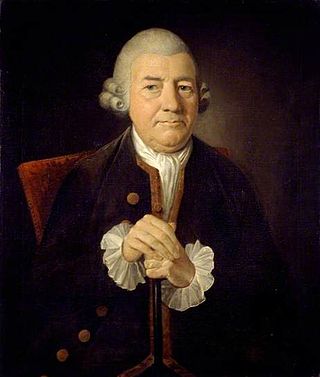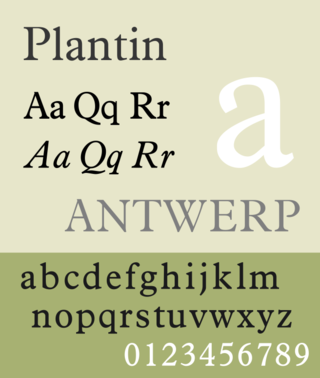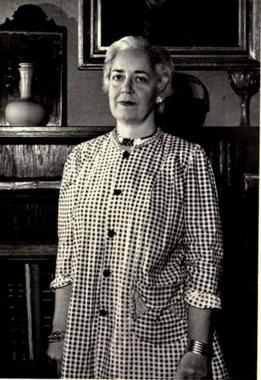Related Research Articles

John Baskerville was an English businessman, in areas including japanning and papier-mâché, but he is best remembered as a printer and type designer. He was also responsible for inventing "wove paper", which was considerably smoother than "laid paper", allowing for sharper printing results.

Printing is a process for mass reproducing text and images using a master form or template. The earliest non-paper products involving printing include cylinder seals and objects such as the Cyrus Cylinder and the Cylinders of Nabonidus. The earliest known form of printing as applied to paper was woodblock printing, which appeared in China before 220 AD for cloth printing. However, it would not be applied to paper until the seventh century. Later developments in printing technology include the movable type invented by Bi Sheng around 1040 AD and the printing press invented by Johannes Gutenberg in the 15th century. The technology of printing played a key role in the development of the Renaissance and the Scientific Revolution and laid the material basis for the modern knowledge-based economy and the spread of learning to the masses.
The Public Printer of the United States was the head of the United States Government Publishing Office (GPO). Pursuant to 44 U.S.C. § 301, this officer was nominated by the President of the United States and approved by the United States Senate. In December 2014, Congress passed and President Obama signed into law H.R. 83, which consolidated and continued appropriations for FY 2015. Section 1301 of that act changed the name of the Government Printing Office to the Government Publishing Office and the title of Public Printer to Director. Thus, Davita Vance-Cooks was the last Public Printer of the United States and the first Director of the U.S. Government Publishing Office.
Private press publishing, with respect to books, is an endeavor performed by craft-based expert or aspiring artisans, either amateur or professional, who, among other things, print and build books, typically by hand, with emphasis on design, graphics, layout, fine printing, binding, covers, paper, stitching, and the like.

Elizabeth Corbet Yeats, known as Lolly, was an Anglo-Irish educator and publisher. She worked as an art teacher and published several books on art, and was a founder of Dun Emer Press which published several works by her brother W. B. Yeats. She was the first commercial printer in Ireland to work exclusively with hand presses.

Alice Christiana Gertrude Meynell was a British writer, editor, critic, and suffragist, now remembered mainly as a poet.

Stanley Arthur Morison was a British typographer, printing executive and historian of printing. Largely self-educated, he promoted higher standards in printing and an awareness of the best printing and typefaces of the past.
Irving Harold Mills was an American music publisher, musician, lyricist, and jazz artist promoter. He often used the pseudonyms Goody Goodwin and Joe Primrose.
Nonesuch Press was a private press founded in 1922 in London by Francis Meynell, his second wife Vera Mendel, and their mutual friend David Garnett, co-owner of Birrell & Garnett's bookshop in Soho's Gerrard Street, in the basement of which the press began.
The International Typographical Union (ITU) was a US trade union for the printing trade for newspapers and other media. It was founded on May 3, 1852, in the United States as the National Typographical Union, and changed its name to the International Typographical Union at its Albany, New York, convention in 1869 after it began organizing members in Canada. The ITU was one of the first unions to admit female members, admitting women members such as Augusta Lewis, Mary Moore and Eva Howard in 1869.

Centaur is a serif typeface by book and typeface designer Bruce Rogers, based on the Renaissance-period printing of Nicolas Jenson around 1470. He used it for his design of the Oxford Lectern Bible. It was given widespread release by the British branch of Monotype, paired with an italic designed by calligrapher Frederic Warde and based on the slightly later work of calligrapher and printer Ludovico Vicentino degli Arrighi. The italic has sometimes been named separately as the "Arrighi" italic.

Charles Henry Chapman was a New Zealand unionist and politician of the Labour Party and various predecessor parties.

Plantin is an old-style serif typeface. It was created in 1913 by the British Monotype Corporation for their hot metal typesetting system and is named after the sixteenth-century printer Christophe Plantin. It is loosely based on a Gros Cicero roman type cut in the 16th century by Robert Granjon held in the collection of the Plantin-Moretus Museum, Antwerp.
Walter Valentine Tracy RDI was an English type designer, typographer and writer.

Lawrence Johnson, was born and educated in England. After an early apprenticeship in the printing industry, he emigrated to America in his youth, and became an eminent stereotyper and type-founder in Philadelphia and one of the most extensive and successful type-founders in the United States.
Fürstlich Sächsischer Hofbuchdruckerei of Altenburg, Germany, is used generically in this article to denote a succession of book printers based in Altenburg, in the German state of Thuringia, that — under various capacities, names, and owners – have endured as one continuous printing operation, without interruption, for four hundred and twenty-nine years — since 1594, the early modern German period. The bookbinding aspect of the business included a bindery.

Jane Bissell Grabhorn (1911–1973) was an American artist, typographer, bookbinder, and printer.

Old Style or Modernised Old Style was the name given to a series of serif typefaces cut from the mid-nineteenth century and sold by the type foundry Miller & Richard, of Edinburgh in Scotland. It was a standard typeface in Britain for literary and prestigious printing in the second half of the nineteenth century and the early twentieth century, with many derivatives and copies released.
The Gotham-Attucks Music Publishing Company was an African-American owned firm based in Manhattan, New York, that was formed July 15, 1905, by merger of the Gotham Music Company and the Attucks Music Publishing Company. The Gotham Music Company was founded by composer Will Marion Cook and songwriter Richard Cecil McPherson (aka Cecil Mack) and the Attucks Music Publishing Company, the first African-American music publishing company in the United States, founded in 1904 by Sheperd Nathaniel Edmonds (1874–1941). Gotham-Attucks ceased to operate as a legitimate music publisher after its sale to the "song shark" Ferdinand E. Miersch in 1911.
Harriet Wainwright Stewart was a British composer, singer, and writer. A musical entrepreneur, she developed a subscription list of several hundred people and sold at least two of her compositions to subscribers.
References
- ↑ "Kynoch Press". The Typographic Hub. Birmingham City University . Retrieved 27 October 2017.
- ↑ Archer, Caroline, PhD (2000). The Kynoch Press: The Anatomy of a Printing House, 1876–1981. Oak Knoll Press. OCLC 45137620; ISBN 9780712347044.Note: Caroline Archer since married Alexandre Parré and is known as Caroline Archer-Parré
- ↑ Drew, Kynoch (1940). "Kynoch Press Diaries". Art and Industry: 73–9. Retrieved 27 October 2017.
The Kynoch Press, as every printer knows, is an offshoot of that vast division of British commerce, Imperial Chemical Industries...the Kynoch Press has one of the most distinctive typographical repertories among printers in this country.
- ↑ Lesley Blanch: Inner Landscapes, Wilder Shores, by Anne Boston, London: John Murray (2010, 2014); OCLC 883517551